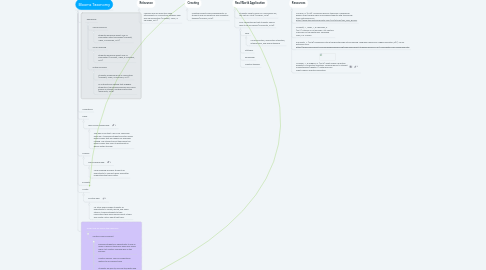
1. Blooms Taxonomy
1.1. Remember
1.1.1. Verbal receiving
1.1.1.1. students remember about 20% of information after two weeks (Crockett, Jukes, & Churches, 2011).
1.1.2. Visual receiving
1.1.2.1. students remember about 50% of information (Crockett, Jukes, & Churches, 2011).
1.1.3. Active receiving
1.1.3.1. Students remember 90% of information (Crockett, Jukes, & Churches, 2011).
1.1.3.2. An instructional method that engages students in the learning process and is also known as student-centered instruction (Kusumoto, 2018).
1.2. Understand
1.3. Apply
1.3.1. Lexia Core5 reading app:
1.3.1.1. This app is one that I use in my classroom each day. It provides students practice using phonics skills that are needed for everyday reading. The students must then apply the phonics skills they learn to participate in games within the app.
1.4. Analyze
1.4.1. Mind mapping app:
1.4.1.1. Mind mapping provides students an opportunity to connect ideas and better understand the topic better.
1.5. Evaluate
1.6. Create
1.6.1. My story app:
1.6.1.1. My story app provides students an opportunity to create, record, and share stories. It allows students to take information they have learned about a topic and create a story about that topic.
1.7. How it can be used in the classroom
1.7.1. Solution fluency project
1.7.1.1. Provides students an opportunity to use all levels of blooms taxonomy while also using many 21st-century learning skills in the process.
1.7.1.2. Solution fluency can be completed in relation to any subject area
1.7.1.3. Students are able to uncover the depth and richness of a topic through solution fluency (McTighe & Wiggins, 2013).
1.7.1.4. Students are given a real-world problem to solve
2. Relevance
2.1. Learners who are effective make attachments or connections between new and old information (Crockett, Jukes, & Churches, 2011).
3. Creating
3.1. Creative projects allow engagements of students and use analytical and evaluative thinking (Cochran, 2016).
4. Real World Application
4.1. Students need to learn for a successful life, not just for a test (Cochran, 2016).
4.2. Four competencies that students should have to be successful (Kusumoto, 2018).
4.2.1. Skills
4.2.1.1. Communication, information utilization, interpersonal, and logical thinking
4.2.2. Attitudes
4.2.3. Knowledge
4.2.4. Creative thinking

